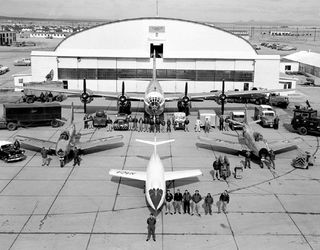Space History Photo: The NACA Test Force

In this historical photo from the U.S. space agency, the fleet of NACA test aircraft are assembled in front of the hangar at the High Speed Flight Stationin January 1952, (later renamed the Dryden Flight Research Center) in Edwards, California.
The white aircraft in the foreground is a Douglas Aircraft D-558-2 Skyrocket. To its left and right are North American F-86 Sabre chase aircraft. Directly behind the D-558-2 is the P2B-1 Superfortress, (the Navy version of the Air Force B-29). Also known as the "mothership," the P2B-1 carried aloft the D-558-2 Skyrocket under its fuselage. Once reaching altitude, the D-558-2 was released from the "mothership" after which the pilot ignited its onboard rocket engine.
The National Advisory Committe on Aeronautics (NACA) was a precursor to NASA. NACA was created by Congress in 1915.
Each weekday, SPACE.com looks back at the history of spaceflight through photos (archive).
Get the Space.com Newsletter
Breaking space news, the latest updates on rocket launches, skywatching events and more!
Join our Space Forums to keep talking space on the latest missions, night sky and more! And if you have a news tip, correction or comment, let us know at: community@space.com.

The National Aeronautics and Space Administration (NASA) is the U.S. government agency in charge of the civilian space program as well as aeronautics and aerospace research. Founded in 1958, NASA is a civilian space agency aimed at exploring the universe with space telescopes, satellites, robotic spacecraft, astronauts and more. The space agency has 10 major centers based across the U.S. and launches robotic and crewed missions from the Kennedy Space Center in Cape Canaveral Florida. It's astronaut corps is based at the Johnson Space Center in Houston. To follow NASA's latest mission, follow the space agency on Twitter or any other social channel, of visit: nasa.gov.
